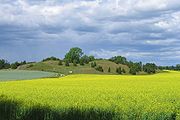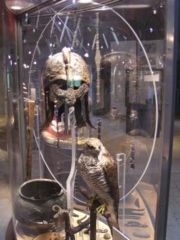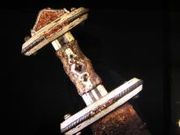
Valsgärde
Encyclopedia


Fyris
Fyrisån is a river in the Swedish province of Uppland, which passes through the city of Uppsala and ends in Lake Mälaren....
river, about three kilometres north of Gamla Uppsala
Gamla Uppsala
Gamla Uppsala is a parish and a village outside Uppsala in Sweden. It had 16,231 inhabitants in 1991.As early as the 3rd century AD and the 4th century AD and onwards, it was an important religious, economic and political centre...
, the ancient centre of the Swedish kings and of the pagan faith in Sweden
Sweden
Sweden , officially the Kingdom of Sweden , is a Nordic country on the Scandinavian Peninsula in Northern Europe. Sweden borders with Norway and Finland and is connected to Denmark by a bridge-tunnel across the Öresund....
. The present farm dates from the 16th century. The farm's notability derives from the presence of a burial site from the Swedish Vendel Age (part of the Iron age
Iron Age
The Iron Age is the archaeological period generally occurring after the Bronze Age, marked by the prevalent use of iron. The early period of the age is characterized by the widespread use of iron or steel. The adoption of such material coincided with other changes in society, including differing...
(c. 550–793) and the Viking Age
Viking Age
Viking Age is the term for the period in European history, especially Northern European and Scandinavian history, spanning the late 8th to 11th centuries. Scandinavian Vikings explored Europe by its oceans and rivers through trade and warfare. The Vikings also reached Iceland, Greenland,...
); it was used for more than 300 years. The first ship burial
Ship burial
A ship burial or boat grave is a burial in which a ship or boat is used either as a container for the dead and the grave goods, or as a part of the grave goods itself. If the ship is very small, it is called a boat grave...
is from the 6th century and the last graves
Grave field
A grave field is a prehistoric cemetery, typically of Bronze Age and Iron Age Europe.Grave fields are distinguished from necropoleis by the former's lack of above-ground structures, buildings, or grave markers.-Types:...
are from the 11th century.
Excavation

Vendel
Vendel is a parish in the Swedish province of Uppland.The village overlooks a long inland stretch of water, Vendelsjön, near which the Vendel river has its confluence with the river Fyris. The church was established in 1310...
, which gave its name to this period of the Scandinavian Iron Age. The graves are princely, and are almost identical to ones found later in England
England
England is a country that is part of the United Kingdom. It shares land borders with Scotland to the north and Wales to the west; the Irish Sea is to the north west, the Celtic Sea to the south west, with the North Sea to the east and the English Channel to the south separating it from continental...
, at Sutton Hoo
Sutton Hoo
Sutton Hoo, near to Woodbridge, in the English county of Suffolk, is the site of two 6th and early 7th century cemeteries. One contained an undisturbed ship burial including a wealth of Anglo-Saxon artefacts of outstanding art-historical and archaeological significance, now held in the British...
in East Anglia
East Anglia
East Anglia is a traditional name for a region of eastern England, named after an ancient Anglo-Saxon kingdom, the Kingdom of the East Angles. The Angles took their name from their homeland Angeln, in northern Germany. East Anglia initially consisted of Norfolk and Suffolk, but upon the marriage of...
. There are several theories about the identities of those buried, ranging from the Yngling
Yngling
The Ynglings were the oldest known Scandinavian dynasty. It can refer to the clans of the Scylfings , the semi-legendary royal Swedish clan during the Age of Migrations, with kings such as Eadgils, Onela and Ohthere...
s (Scylfings) to powerful warriors within the Leidang
Leidang
The institution known as leiðangr , leidang , leding, , ledung , expeditio or sometimes lething , was a public levy of free farmers typical for medieval Scandinavians. It was a form of conscription to organise coastal fleets for seasonal excursions and in defence of the realm...
system, or local strongmen who had enriched themselves through trade due to the area's strategic position between the fjord
Fjord
Geologically, a fjord is a long, narrow inlet with steep sides or cliffs, created in a valley carved by glacial activity.-Formation:A fjord is formed when a glacier cuts a U-shaped valley by abrasion of the surrounding bedrock. Glacial melting is accompanied by rebound of Earth's crust as the ice...
of Mälaren
Mälaren
Lake Mälaren is the third-largest lake in Sweden, after Lakes Vänern and Vättern. Its area is 1,140 km² and its greatest depth is 64 m. Mälaren spans 120 kilometers from east to west...
and the important region of Tiundaland
Tiundaland
Tiundaland is a historic region, Folkland, and since 1296 part of the modern province of Uppland. It originally meant the land of the ten hundreds and referred to its duty of providing 1000 men and 40 ships for the Swedish king's leidang....
. There are so many rich graves that it is unlikely that most of them were royalty.
External links
- Gamla Uppsala — Archæological information from the Swedish National Heritage Board.
- Valsgärde — Article by Claes-Henric Siven on gravesite

